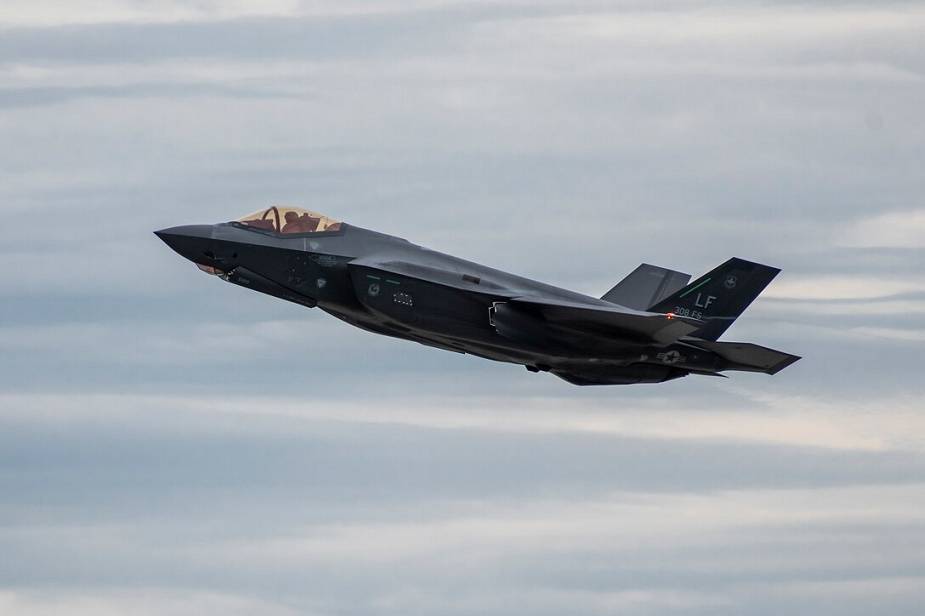According to information published by the U.S. Department of Defense on November 10, 2020, the U.S. State Department has made a determination approving a possible Foreign Military Sale to the Government of the United Arab Emirates of 50 F-35 Joint Strike Fighters stealth aircraft and related equipment for an estimated cost of $10.4 billion.
Follow Air Recognition on Google News at this link
 An F-35A Lightning II from Luke Air Force Base, Ariz., takes off from Dover AFB, Del., Feb. 19, 2020. (Picture source US Air Force)
An F-35A Lightning II from Luke Air Force Base, Ariz., takes off from Dover AFB, Del., Feb. 19, 2020. (Picture source US Air Force)
The Government of the United Arab Emirates (UAE) has requested to buy up to fifty (50) F-35A Joint Strike Fighter Conventional Take-Off and Landing (CTOL) aircraft and fifty-four (54) Pratt & Whitney F-135 Engines (up to 50 installed and 4 spares). Also included are Electronic Warfare Systems; Command, Control, Communications, Computer and Intelligence/Communications, Navigational, and Identification (C4I/CNI); Autonomic Logistics Global Support System (ALGS); Operational Data Integrated Network (ODIN); Air System Training Devices; Weapons Employment Capability and other Subsystems, Features, and Capabilities; F-35 unique chaff and infrared flares; reprogramming center access; F-35 Performance Based Logistics; software development/integration; aircraft ferry and tanker support; aircraft and munitions support and test equipment; communications equipment; provisioning, spares and repair parts; weapons repair and return support; personnel training and training equipment; weapon systems software, publications and technical documents; U.S. Government and contractor engineering, technical, and logistics support services; and other related elements of logistical and program support. The total estimated cost is $10.4 billion.
The proposed sale of F-35s will provide the Government of the UAE with a credible defense capability to deter aggression in the region and ensure interoperability with U.S. forces. The UAE has demonstrated a commitment to modernizing its military and will have no difficulty absorbing these aircraft into their armed forces.
The prime contractors will be Lockheed Martin Aeronautics Company, Fort Worth, TX; and Pratt & Whitney Military Engines, East Hartford, CT. There are no known offset agreements proposed in connection with this potential sale. However, the purchaser typically requests offsets. Any offset agreements will be defined in negotiations between the purchaser and the contractor(s). Implementation of this proposed sale may require the assignment of U.S. Government or contractor representatives to the UAE.
Implementation of this proposed sale will require multiple trips to the UAE involving U.S. Government and contractor representatives for technical reviews/support, program management, and training over the life of the program. U.S. contractor representatives will be required in the UAE to conduct Contractor Engineering Technical Services (CETS) and Autonomic Logistics and Global Support (ALGS) for after-aircraft delivery.
This is the first foreign sale of F-35 in the Middle East, but the stealth fighter aircraft is already in service with the Israeli Air Force. End of October 2020, it was announced that the Trump administration has informally notified Congress of its intent to move forward with a major arms sale to the United Arab Emirates involving advanced F-35 jets.
Today, the F-35 is in already use or will enter service with Australia, Belgium, Denmark, Israel, Italy, Japan, Netherlands, Norway, Poland, South Korea, Singapore, United Kingdom, and the United States.
The F-35 Lightning II is an American family of single-seat, single-engine, all-weather stealth multirole combat aircraft developed and manufactured by the American company Lockheed Martin. The fighter is designed to perform both air superiority and strike missions. It is also able to provide electronic warfare and intelligence, surveillance, and reconnaissance capabilities.
The F-35’s electronic sensors include the Electro-Optical Distributed Aperture System (DAS). This system provides pilots with situational awareness in a sphere around the aircraft for enhanced missile warning, aircraft warning, and day/night pilot vision. Additionally, the aircraft is equipped with the Electro-Optical Targeting System. The internally mounted EOTS provides extended range detection and precision targeting against ground targets, plus long-range detection of air-to-air threats.
The F-35’s helmet-mounted display system is the most advanced system of its kind. All the intelligence and targeting information an F-35 pilot needs to complete the mission is displayed on the helmet’s visor.
The F-35 contains state-of-the-art tactical data links that provide the secure sharing of data among its flight members as well as other airborne, surface and ground-based platforms required to perform assigned missions. The commitment of JSF partner nations to common communications capabilities and web-enabled logistics support will enable a new level of Coalition interoperability.
F-35 weapons are carried in two parallel bays located in front of the landing gear equipped with two hardpoints able to carry bombs and missiles. The F-35 is designed to provide the pilot with unsurpassed situational awareness, positive target identification, and precision strike in all weather conditions. Mission systems integration and outstanding over-the-nose visibility features are designed to dramatically enhance pilot performance.
















